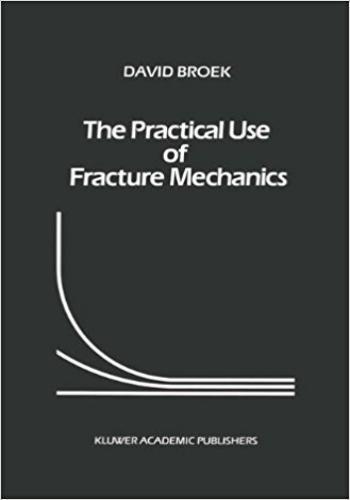Admin
مدير المنتدى


عدد المساهمات : 18996
التقييم : 35494
تاريخ التسجيل : 01/07/2009
الدولة : مصر
العمل : مدير منتدى هندسة الإنتاج والتصميم الميكانيكى
 |  موضوع: كتاب The Practical Use of Fracture Mechanics - David Broek موضوع: كتاب The Practical Use of Fracture Mechanics - David Broek  الأربعاء 08 نوفمبر 2017, 8:53 pm الأربعاء 08 نوفمبر 2017, 8:53 pm | |
| 
أخوانى فى الله
أحضرت لكم كتاب
The Practical Use of Fracture Mechanics
David Broek

ويتناول الموضوعات الأتية :
Contents
Preface v
Notice vn
Chapter 1 . INTRODUCTION
1 . 1 . Fracture control
1.2. The two objectives of damage tolerance analysis
1.3. Crack growth and fracture
1.4. Damage tolerance and fracture mechanics
1.5. The need for analysis: purpose of this book
1.6. Exercises
Chapter 2. EFFECTS OF CRACKS AND NOTCHES: COLLAPSE
2.1. Scope
2.2. An interrupted load path
2.3. Stress concentration factor
2.4. State of stress at a stress concentration
2.5. Yielding at a notch
2.6. Plastic collapse at a notch
2.7. Fracture at notches: brittle behavior
2.8. Measurement of collapse strength
2.9. Exercises
Chapter 3. LINEAR ELASTIC FRACTURE MECHANICS
3.1. Scope
3.2. Stress at a crack tip
3.3. General form of the stress intensity factor
3.4. Toughness
3.5. Plastic zone and stresses in plane stress and plane strain
3.6. Thickness dependence of toughness
3.7. Measurement of toughness
3.8. Competition with plastic collapse
3.9. The energy criterion
3.10. The energy release rate
3.11. The meaning of the energy criterion
3.12. The rise in fracture resistance: redefinition of toughness
3.13. Exercises
Chapter 4. ELASTIC-PLASTIC FRACTURE MECHANICS 88
4.1. Scope
4.2. The energy criterion for plastic fracture
4.3. The fracture criterion
4.4. The rising fracture energy
4.5. The residual strength diagram in EPFM: collapse
4.6. The measurement of the toughness in EPFM
4.7. The parameters of the stress-strain curve
4.8. The /i-functions
4.9. Accuracy
4.10. Historical development of J
4.11. Limitations of EPFM
4.12. CTOD measurements
4.13. Exercises
Chapter 7. DATA INTERPRETATION AND USE
7.1. Scope
7.2. Plane strain fracture toughness
7.3. Plane stress and transitional toughness, R-curve
7.4. Toughness in terms of J and JR
7.5. Estimates of toughness
7.6. General remarks on fatigue rate data
7.7. Fitting the da/dN data
7.8. Dealing with scatter in rate data
7.9. Accounting for the environmental effect
7.10. Obtaining retardation parameters
7.11. Exercises
121 Chapter 8. GEOMETRY FACTORS
8.1. Scope
8.2. The reference stress
8.3. Compounding
8.4. Superposition
8.5. A simple method for asymmetric loading cases
8.6. Some easy guesses
8.7. Simple solutions for holes and stress concentrations
8.8. Simple solutions for irregular stress distributions
8.9. Finite element analysis
8.10. Simple solutions for crack arresters and multiple elements
8.11. Geometry factors for elastic-plastic fracture mechanics
8.12. Exercises
Chapter 5. CRACK GROWTH ANALYSIS CONCEPTS 123
5.1. Scope
5.2. The concept underlying fatigue crack growth
5.3. Measurement of the rate function
5.4. Rate equations
5.5. Constant amplitude crack growth in a structure
5.6. Load interaction: Retardation
5.7. Retardation models
5.8. Crack growth analysis for variable amplitude loading
5.9. Parameters affecting fatigue crack growth rates
5.10. Stress corrosion cracking
5.11. Exercises
Chapter 9. SPECIAL SUBJECTS
9.1. Scope
9.2. Behavior of surface flaws and corner cracks
9.3. Break through: leak-before-break
9.4. Fracture arrest
9.5. Multiple elements, multiple cracks, changing geometry
9.6. Stop holes, cold worked holes and interference fasteners
Residual stresses in general
9.8. Other loading modes: mixed mode loading
9.9. Composites
9.10. Exercises
Chapter 6. LOAD SPECTRA AND STRESS HISTORIES
6.1. Scope
6.2. Types of stress histories
6.3. Obtaining load spectra
6.4. Exceedance diagram
6.5. Stress history generation
6.6. Clipping
6.7. Truncation
6.8. Manipulation of stress history
6.9. Environmental effects
6.10. Standard spectra
6.11. Exercises
Chapter 10. ANALYSIS PROCEDURES
10.1. Scope
10.2. Ingredients and critical locations
Chapter 14. APPLICATIONS
14.1. Scope
14.2. Storage tank (fictitious example)
Fracture arrest in ships
14.4. Piping in chemical plant (fictitious example)
14.5. Fatigue cracks in railroad rails
14.6. Underwater pipeline
14.7. Closure
10.3. Critical locations and flaw assumptions 334
10.4. LEFM versus EPFM
10.5. Residual strength analysis
10.6. Use of R-curve and JR-curve
10.7. Crack growth analysis
10.8. Exercises
Chapter II. FRACTURE CONTROL 362
11.1. Scope
11.2. Fracture control options
11.3. The probability of missing the crack
11.4. The physics and statistics of crack detection
11.5. Determining the inspection interval
11.6. Fracture control plans
11.7. Repairs
11.8. Statistical aspects
11.9. The cost of fracture and fracture control
11.10. Exercises
362 Chapter 15. SOLUTIONS TO EXERCISES 485
373 SUBJECT INDEX 515
Chapter 12. DAMAGE TOLERANCE SUBSTANTIATION 391
12.1. Scope
12.2. Objectives
12.3. Analysis and damage tolerance substantiation
12.4. Options to improve damage tolerance
12.5. Aircraft damage tolerance requirements
12.6. Other requirements
12.7. Flaw assumptions
12.8. Sources of error and safety factors
12.9. Misconceptions
12.10. Outlook
12.11. Exercises
Chapter 13. AFTER THE FACT: FRACTURE MECHANICS AND
FAILURE ANALYSIS 424
13.1. Scope 424
13.2. The cause of service fractures
13.3. Fractography
13.4. Features of use in fracture mechanics analysis
13.5. Use of fracture mechanics
13.6. Possible actions based on failure analysis
13.7. Exercises
كلمة سر فك الضغط : books-world.net
The Unzip Password : books-world.net
أتمنى أن تستفيدوا منه وأن ينال إعجابكم
رابط مباشر لتنزيل كتاب The Practical Use of Fracture Mechanics - David Broek
رابط من موقع عالم الكتب لتنزيل كتاب The Practical Use of Fracture Mechanics - David Broek 
|
|







